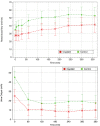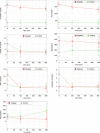Changes in hemodynamics, renal blood flow and urine output during continuous renal replacement therapies
- PMID: 33247145
- PMCID: PMC7695709
- DOI: 10.1038/s41598-020-77435-x
Changes in hemodynamics, renal blood flow and urine output during continuous renal replacement therapies
Abstract
Continuous renal replacement therapies (CRRT) affect hemodynamics and urine output. Some theories suggest a reduced renal blood flow as the cause of the decreased urine output, but the exact mechanisms remain unclear. A prospective experimental study was carried out in 32 piglets (2-3 months old) in order to compare the impact of CRRT on hemodynamics, renal perfusion, urine output and renal function in healthy animals and in those with non-oliguric acute kidney injury (AKI). CRRT was started according to our clinical protocol, with an initial blood flow of 20 ml/min, with 10 ml/min increases every minute until a goal flow of 5 ml/kg/min. Heart rate, blood pressure, central venous pressure, cardiac output, renal blood flow and urine output were registered at baseline and during the first 6 h of CRRT. Blood and urine samples were drawn at baseline and after 2 and 6 h of therapy. Blood pressure, cardiac index and urine output significantly decreased after starting CRRT in all piglets. Renal blood flow, however, steadily increased throughout the study. Cisplatin piglets had lower cardiac index, higher vascular resistance, lower renal blood flow and lower urine output than control piglets. Plasma levels of ADH and urine levels of aquaporin-2 were lower, whereas kidney injury biomarkers were higher in the cisplatin group of piglets. According to our findings, a reduced renal blood flow doesn't seem to be the cause of the decrease in urine output after starting CRRT.
Conflict of interest statement
The authors declare no competing interests.
Figures





Similar articles
-
Hemodynamic Effects of Connection to Continuous Renal Replacement Therapy in a Pediatric Animal Model.Artif Organs. 2018 Jun;42(6):640-646. doi: 10.1111/aor.13086. Epub 2018 Feb 6. Artif Organs. 2018. PMID: 29405326
-
Urine output is associated with prognosis in patients with acute kidney injury requiring continuous renal replacement therapy.J Crit Care. 2013 Aug;28(4):379-88. doi: 10.1016/j.jcrc.2012.11.019. Epub 2013 Apr 10. J Crit Care. 2013. PMID: 23582311
-
Continuous renal replacement therapy is associated with acute cardiac stunning in critically ill patients.Hemodial Int. 2019 Jul;23(3):325-332. doi: 10.1111/hdi.12760. Epub 2019 May 15. Hemodial Int. 2019. PMID: 31094070
-
Clarifications on Continuous Renal Replacement Therapy and Hemodynamics.Chin Med J (Engl). 2017 May 20;130(10):1244-1248. doi: 10.4103/0366-6999.205863. Chin Med J (Engl). 2017. PMID: 28485326 Free PMC article. Review.
-
Cardiovascular and renal effects of dopamine and dobutamine in healthy, conscious piglets.Crit Care Med. 1988 Apr;16(4):340-5. doi: 10.1097/00003246-198804000-00007. Crit Care Med. 1988. PMID: 3280243 Review.
Cited by
-
Impact of Continuous Renal Replacement Therapy Initiation on Urine Output and Fluid Balance: A Multicenter Study.Blood Purif. 2023;52(6):532-540. doi: 10.1159/000530146. Epub 2023 Apr 18. Blood Purif. 2023. PMID: 37071971 Free PMC article.
-
Posterior ischemic optic neuropathy following continuous renal replacement therapy: a case report.Int J Emerg Med. 2025 Mar 28;18(1):62. doi: 10.1186/s12245-025-00872-w. Int J Emerg Med. 2025. PMID: 40155826 Free PMC article.
-
The relationship between commencement of continuous renal replacement therapy and urine output, fluid balance, mean arterial pressure and vasopressor dose.Crit Care Resusc. 2023 Oct 18;24(3):259-267. doi: 10.51893/2022.3.OA5. eCollection 2022 Sep 5. Crit Care Resusc. 2023. PMID: 38046211 Free PMC article.
-
Focus on oliguria during renal replacement therapy.J Anesth. 2024 Oct;38(5):681-691. doi: 10.1007/s00540-024-03342-4. Epub 2024 May 22. J Anesth. 2024. PMID: 38777933 Free PMC article. Review.
References
Publication types
MeSH terms
Substances
LinkOut - more resources
Full Text Sources
Medical

